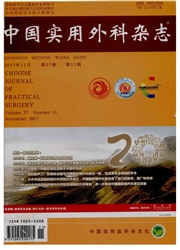

 中文摘要:
中文摘要:
目的 探讨腹腔镜胰十二指肠切除术(LPD)的可行性和近期疗效。方法 回顾性分析浙江省人民医院肝胆胰外科及微创外科(67例)和吉林大学第一医院肝胆胰外二科(13例)自2013年12月至2016年1月实施LPD80例病人的临床资料,对临床疗效进行分析。结果 77例病人手术成功,3例中转开放手术,其中5例联合门静脉-肠系膜上静脉切除重建。腹腔镜捆绑式胰胃吻合7例,腹腔镜和机器人辅助胰管对空肠黏膜吻合分别为45例和25例。平均手术时间为(351.2±84.1)min,平均术中出血量为(204.7±165.9)m L,术后平均住院时间为(16.6±10.1)d。术后并发症包括:胰瘘11例,其中A级6例、B级3例、C级2例,2例C级胰瘘均再次手术引流后治愈,其余胰瘘均非手术治疗治愈;腹腔内出血3例,2例再次手术治愈,1例两次动脉栓塞后主动出院;消化道出血3例,2例再次手术治愈,1例非手术治疗治愈;输入袢梗阻2例再次手术治愈;胃排空障碍5例和胆漏6例,均非手术治疗治愈。术后病理学检查结果:胰头导管腺癌32例、十二指肠乳头癌16例、胆总管下端癌和壶腹部癌23例、导管内乳头状黏液肿瘤4例、神经内分泌肿瘤2例、浆液性囊腺瘤1例、黏液性囊腺瘤1例、十二指肠管状绒毛状腺瘤1例。所有病例均R0切除。结论 在较大的微创胰腺外科中心可安全有序地开展LPD,术中可使用达芬奇机器人手术系统辅助胰消化道和血管重建。
 英文摘要:
英文摘要:
Objective To investigate the role of Laparoscopic and robotic assisted pancreaticoduodenectomy (LPD)in periampullary lesions. Methods The clinical data including perioperative and short-term outcomes of 80 cases of LPD performed in Zhejiang provincial people' s hospital (67) and Frist clinical hospital of Jilin university (13) between 2013.12 and 2016.01 were reviewed retrospectively. Results 80 patients attempted LPD while three (3.8%) required conversation to open procedure. Five patients (6.3%) underwent LPD combined with partial resection of portal vein or superior mesentery vein. The mean operation time was (351.2-+ 84.1 )minutes, estimated blood loss was (204.7-+ 165.9) ml and mean postoperative hospital stay was (16.6-+ 10.1) days. Seven cases underwent binding pancreatieo-gastric anastomosis while other cases were all underwent pancreatico-jejunostomy duct to mueosa anastomosis including 45 cases performed under laparoscopic system and 25 cases performed under Robotic system. 11 cases had pancreatic fistula according to ISGPF definition, including six cases of grade A, three cases of grade B and two cases of grade C (reoperation was required for postoperative intra-abdominal hemorrhage). Three patients suffered from postoperative intra-abdominal bleeding. Three patients had gastrointestinal bleeding. Five patients had delayed gastric empty and six cases had bile leakage after operation. Pathologic results showed pancreatic ductal adenocarcinomas in 32 patients,duodenal papillary adenocarcinoma in 16 patients, adenocarcinomas at ampulla of Vater or common bile duct in 23 cases, intraductal papillary mucinous neoplasms in four patients, neuroendocrine tumors in two patients and other disease in three patients. All patients underwent R0 resection. Conclusion Our results show that the LPD is technique safe and feasible at high volume minimal invasive and pancreatic centers. Da-Vinci robotic system has advantage in pancreatojejunal and portal vein reconstruction.
 同期刊论文项目
同期刊论文项目
 同项目期刊论文
同项目期刊论文
 期刊信息
期刊信息
